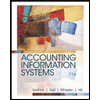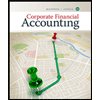
INTER. ACCOUNTING - CONNECT+ALEKS ACCESS
10th Edition
ISBN: 9781264770335
Author: SPICELAND
Publisher: MCG
expand_more
expand_more
format_list_bulleted
Concept explainers
Textbook Question
Chapter 3, Problem 3.2DMP
Analysis Case 3–2
Current versus long- term classification
• LO3–2, LO3–3
The usefulness of the
Required:
1. Discuss the factors that determine whether an asset or liability should be classified as current or long-term in a balance sheet.
2. Identify six items that under different circumstances could be classified as either current or long-term. Indicate the factors that would determine the correct classification.
Expert Solution & Answer
Trending nowThis is a popular solution!

Students have asked these similar questions
ayco Inc. started its operations in 2022. Its sales during 2022, all on account, totalled $700,000. The company collected $500,000 in cash from customers during the year and wrote off $8,000 in uncollectible accounts. The company set up an allowance for doubtful accounts at December 31, 2022, its fiscal year-end, and determined the account balance to be $14,000.
The unadjusted balances of selected accounts at December 31, 2023 are as follows:
Accounts receivable
$
300,000
Allowance for doubtful accounts (debit)
10,000
Sales revenue (including 80 percent in sales on account)
800,000
Aging of the accounts receivable on December 31, 2023, resulted in an estimate of $11,000 in potentially uncollectible accounts.
Required:
1. Prepare the journal entries to record all the transactions during 2022 and post them to appropriate T-accounts. (If no entry is required for a transaction/event, select "No journal entry required" in the first account field.)…
Calculate the sample size based on the specifications in Buhi's contract. Make sure it is within budget, reasonable to obtain, and that you use appropriate inputs relative to market research best practices.
Use the calculator to adjust the sample size statement.
Use the agreed-upon sample size in Buhi's contract: 996.
In your secondary research, find the target population size (an estimate of those in the United States looking to purchase luggage in the category in the next two years). You will use this target population size for each sample size estimate.
Adjust the provided sample size calculator inputs to find the rest of the figures that get you to the agreed-upon sample size.
The caveats from Buhi are that you must:
Use the market research standard for your confidence level.
Use a confidence interval that is better than the market research standard for your confidence interval.
The partnership of Keenan and Kludlow paid the following wages during this year:
Line Item Description
Amount
M. Keenan (partner)
$108,000
S. Kludlow (partner)
96,000
N. Perry (supervisor)
54,700
T. Lee (factory worker)
35,100
R. Rolf (factory worker)
27,200
D. Broch (factory worker)
6,300
S. Ruiz (bookkeeper)
26,000
C. Rudolph (maintenance)
5,200
In addition, the partnership owed $250 to Rudolph for work he performed during December. However, payment for this work will not be made until January of the following year. The state unemployment tax rate for the company is 2.95% on the first $9,000 of each employee's earnings. Compute the following:
ound your answers to the nearest cent.
a. Net FUTA tax for the partnership for this year
b. SUTA tax for this year
Chapter 3 Solutions
INTER. ACCOUNTING - CONNECT+ALEKS ACCESS
Ch. 3 - Prob. 3.1QCh. 3 - Prob. 3.2QCh. 3 - Define current assets and list the typical asset...Ch. 3 - Prob. 3.4QCh. 3 - Prob. 3.5QCh. 3 - Prob. 3.6QCh. 3 - Describe the common characteristics of assets...Ch. 3 - Prob. 3.8QCh. 3 - Prob. 3.9QCh. 3 - Define the terms paid-in-capital and retained...
Ch. 3 - Disclosure notes are an integral part of the...Ch. 3 - A summary of the companys significant accounting...Ch. 3 - Define a subsequent event.Ch. 3 - Prob. 3.14QCh. 3 - Prob. 3.15QCh. 3 - Prob. 3.16QCh. 3 - Prob. 3.17QCh. 3 - Show the calculation of the following solvency...Ch. 3 - Prob. 3.19QCh. 3 - Prob. 3.20QCh. 3 - (Based on Appendix 3) Segment reporting...Ch. 3 - Prob. 3.22QCh. 3 - Prob. 3.23QCh. 3 - Current versus long-term classification LO32,...Ch. 3 - Prob. 3.3BECh. 3 - Balance sheet preparation; missing elements LO32,...Ch. 3 - Financial statement disclosures LO34 For each of...Ch. 3 - Calculating ratios; solving for unknowns LO38 The...Ch. 3 - Balance sheet classification LO32, LO33 The...Ch. 3 - Prob. 3.3ECh. 3 - Prob. 3.9ECh. 3 - Financial statement disclosures LO34 The...Ch. 3 - Prob. 3.13ECh. 3 - FASB codification research LO32, LO34 Access the...Ch. 3 - Prob. 3.15ECh. 3 - Prob. 3.17ECh. 3 - Prob. 3.20ECh. 3 - Prob. 3.22ECh. 3 - Prob. 3.1PCh. 3 - Prob. 3.2PCh. 3 - Communication Case 31 Current versus long-term...Ch. 3 - Analysis Case 32 Current versus long- term...Ch. 3 - Prob. 3.4DMPCh. 3 - Prob. 3.9DMPCh. 3 - Prob. 3.11DMPCh. 3 - Prob. 3.15DMPCh. 3 - Ethics Case 316 Segment reporting Appendix 3 You...Ch. 3 - Prob. 3.17DMPCh. 3 - Prob. 2CCTC
Knowledge Booster
Learn more about
Need a deep-dive on the concept behind this application? Look no further. Learn more about this topic, accounting and related others by exploring similar questions and additional content below.Similar questions
arrow_back_ios
SEE MORE QUESTIONS
arrow_forward_ios
Recommended textbooks for you
 Financial & Managerial AccountingAccountingISBN:9781285866307Author:Carl Warren, James M. Reeve, Jonathan DuchacPublisher:Cengage Learning
Financial & Managerial AccountingAccountingISBN:9781285866307Author:Carl Warren, James M. Reeve, Jonathan DuchacPublisher:Cengage Learning AccountingAccountingISBN:9781337272094Author:WARREN, Carl S., Reeve, James M., Duchac, Jonathan E.Publisher:Cengage Learning,
AccountingAccountingISBN:9781337272094Author:WARREN, Carl S., Reeve, James M., Duchac, Jonathan E.Publisher:Cengage Learning, Auditing: A Risk Based-Approach to Conducting a Q...AccountingISBN:9781305080577Author:Karla M Johnstone, Audrey A. Gramling, Larry E. RittenbergPublisher:South-Western College Pub
Auditing: A Risk Based-Approach to Conducting a Q...AccountingISBN:9781305080577Author:Karla M Johnstone, Audrey A. Gramling, Larry E. RittenbergPublisher:South-Western College Pub Accounting Information SystemsFinanceISBN:9781337552127Author:Ulric J. Gelinas, Richard B. Dull, Patrick Wheeler, Mary Callahan HillPublisher:Cengage Learning
Accounting Information SystemsFinanceISBN:9781337552127Author:Ulric J. Gelinas, Richard B. Dull, Patrick Wheeler, Mary Callahan HillPublisher:Cengage Learning Corporate Financial AccountingAccountingISBN:9781305653535Author:Carl Warren, James M. Reeve, Jonathan DuchacPublisher:Cengage Learning
Corporate Financial AccountingAccountingISBN:9781305653535Author:Carl Warren, James M. Reeve, Jonathan DuchacPublisher:Cengage Learning Corporate Financial AccountingAccountingISBN:9781337398169Author:Carl Warren, Jeff JonesPublisher:Cengage Learning
Corporate Financial AccountingAccountingISBN:9781337398169Author:Carl Warren, Jeff JonesPublisher:Cengage Learning

Financial & Managerial Accounting
Accounting
ISBN:9781285866307
Author:Carl Warren, James M. Reeve, Jonathan Duchac
Publisher:Cengage Learning

Accounting
Accounting
ISBN:9781337272094
Author:WARREN, Carl S., Reeve, James M., Duchac, Jonathan E.
Publisher:Cengage Learning,

Auditing: A Risk Based-Approach to Conducting a Q...
Accounting
ISBN:9781305080577
Author:Karla M Johnstone, Audrey A. Gramling, Larry E. Rittenberg
Publisher:South-Western College Pub

Accounting Information Systems
Finance
ISBN:9781337552127
Author:Ulric J. Gelinas, Richard B. Dull, Patrick Wheeler, Mary Callahan Hill
Publisher:Cengage Learning

Corporate Financial Accounting
Accounting
ISBN:9781305653535
Author:Carl Warren, James M. Reeve, Jonathan Duchac
Publisher:Cengage Learning

Corporate Financial Accounting
Accounting
ISBN:9781337398169
Author:Carl Warren, Jeff Jones
Publisher:Cengage Learning
ACCOUNTING BASICS: Debits and Credits Explained; Author: Accounting Stuff;https://www.youtube.com/watch?v=VhwZ9t2b3Zk;License: Standard Youtube License